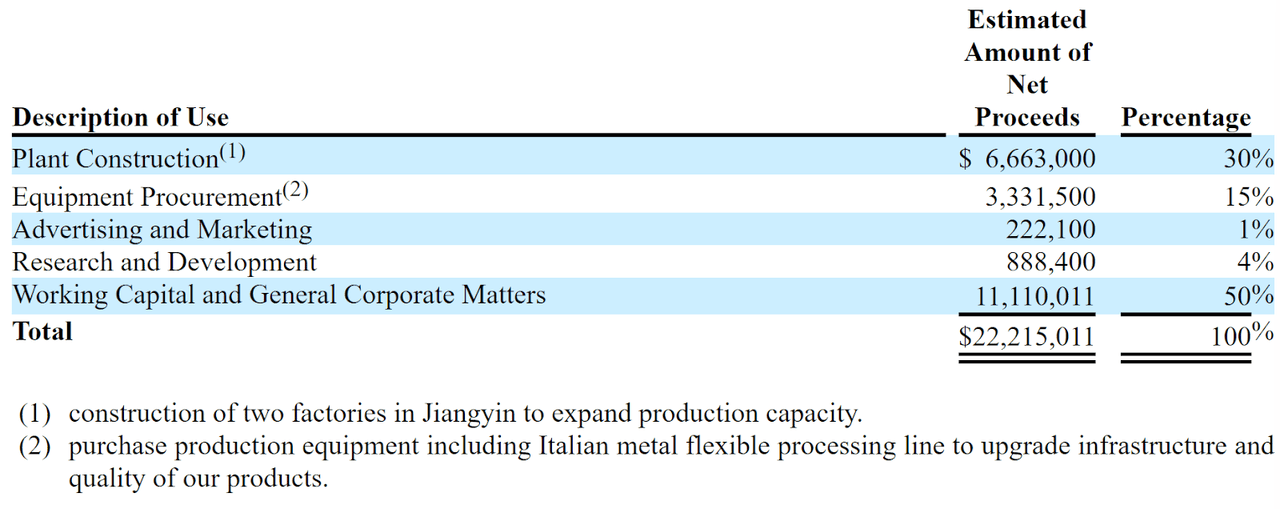onurdongel
What Is Li Bang International?
Jiangyin City, China-based Li Bang International (LBGJ) was founded to design and manufacture stainless steel commercial kitchen equipment and provide related services.
Management is headed by Chairman and CEO Mr. Feng Huang, who has been with the firm since October 2007 and was previously sales manager at Suzhou Hongtu Sanbao Technology Development Co.
The company’s primary offerings include:
-
Commercial kitchen design
-
Stainless steel kitchen equipment
-
Equipment installation
-
After-sales maintenance
Li Bang has booked fair market value investment of $2.6 million as of June 30, 2021, from investors, including Maple Huang Holdings (Chairman Huang), Army Chan Holdings, and Funa Lee Holdings.
The firm has disclosed no specific ESG initiatives at a company level.
According to a 2021 market research report by Fior Markets, the global commercial cooking equipment market was an estimated $85 billion in 2020 and is expected to reach $140 billion by 2028.
This represents a forecast CAGR of 6.5% from 2021 to 2028.
The main drivers for this expected growth are the expected growth of the travel and tourist industry as well as demand for more efficient approaches to reduce costs amid growing urban populations.
However, the COVID-19 pandemic has put a damper on growth in the travel and tourist industry from 2020 onward, so the estimated CAGR may be optimistic.
Major competitive or other industry participants include Shanghai Jiuzong Restaurant Equipment Co., Ltd., Shanghai Dingda Stainless Steel Kitchen Equipment Manufacturing Co., Ltd., Hangzhou Jiulong Kitchenware Manufacturing Co., Ltd., Hangzhou Zhongxin Stainless Steel Products Co., Ltd., Wuxi Jinda Kitchen Equipment Co., Ltd., Nanjing Guanglong Kitchen Equipment and Engineering Co., Ltd., Yangzhou Hainiu Kitchen Equipment Co., Ltd., and Nanjing Huayi Hotel Equipment Manufacturing Engineering Co., Ltd.’ (Source)
Li Bang’s IPO Date & Details
The initial public offering, or IPO, for Li Bang is scheduled for the week ending September 30, 2022.
(Warning: Compared to stocks with more history, IPOs typically have less information for investors to review and analyze. For this reason, investors should use caution when thinking about investing in an IPO, or immediately post-IPO. Also, investors should keep in mind that many IPOs are heavily marketed, past company performance is not a guarantee of future results and potential risks may be understated.)
LBGJ intends to sell 5.0 million shares of common stock at a proposed midpoint price of $5.00 per share for gross proceeds of approximately $25.0 million, not including the sale of customary underwriter options.
No existing or potentially new shareholders have indicated an interest to purchase shares at the IPO price.
Chairman and CEO Huang Feng will have voting control of the company immediately post-IPO.
Assuming a successful IPO at the midpoint of the proposed price range, the company’s enterprise value at IPO (excluding underwriter options) would approximate $92.3 million.
The float to outstanding shares ratio (excluding underwriter options) will be approximately 22.7%. A figure under 10% is generally considered a ‘low float’ stock which can be subject to significant price volatility.
Per the firm’s most recent regulatory filing, it plans to use the net proceeds as follows:
Proposed Use Of IPO Proceeds (SEC EDGAR)
Management’s presentation of the company roadshow is not available.
Regarding outstanding legal proceedings, management says the firm is not involved in any legal or administrative litigation that would have a material adverse effect on its financial condition or operations.
The sole listed bookrunner of the IPO is Univest Securities.
How To Invest In The Company’s Stock: 7 Steps
Investors can buy shares of the stock in the same way they may buy stocks of other publicly-traded companies, or as part of the pre-IPO allocation.
Note: This report is not a recommendation to purchase stock or any other security. For investors who are interested in pursuing a potential investment after the IPO is complete, the following steps for buying stocks will be helpful.
Step 1: Understand The Company’s Financial History
Although there is not much public financial information available about the company, investors can look at the company’s financial history on their form S-1 or F-1 SEC filing (Source).
Step 2: Assess The Company’s Financial Reports
The primary financial statements available for publicly-traded companies include the income statement, balance sheet, and statement of cash flows. These financial statements can help investors learn about a company’s cash capitalization structure, cash flow trends and financial position.
My summary of the Company’s recent financial results is below:
The company’s financials have produced higher topline revenue from a small base, growing gross profit but slightly reduced gross margin, increased operating profit but lowered cash flow from operations.
Free cash flow for the twelve months ended June 30, 2021, was $326,968.
Selling expenses as a percentage of total revenue have dropped as revenue has increased; its Selling efficiency rate was a high 8.7x in the most recent fiscal year.
The firm currently plans to pay no dividend on its shares and anticipates that it will reinvest all earnings into its growth efforts.
Step 3: Evaluate The Company’s Potential Compared To Your Investment Horizon
When investors evaluate potential stocks to buy, it’s important to consider their time horizon and risk tolerance before buying shares. For example, a swing-trader may be interested in short-term growth potential, whereas a long-term investor may prioritize strong financials ahead of short-term price movements.
Step 4: Select A Brokerage
Investors who do not already have a trading account will begin with the selection of a brokerage firm. The account types commonly used for trading stocks include a standard brokerage account or a retirement account like an IRA.
Investors who prefer advice for a fee can open a trading account with a full-service broker or an independent investment advisor and those who want to manage their portfolio for a reduced cost may choose a discount brokerage company.
Step 5: Choose An Investment Size And Strategy
Investors who have decided to buy shares of company stock should consider how many shares to purchase and what investment strategy to adopt for their new position. The investment strategy will guide an investors’ holding period and exit strategy.
Many investors choose to buy and hold stocks for lengthy periods. Examples of basic investing strategies include swing trading, short-term trading or investing over a long-term holding period.
For investors wishing to gain a pre-IPO allocation of shares at the IPO price, they would ‘indicate interest’ with their broker in advance of the IPO. Indicating an interest is not a guarantee that the investor will receive an allocation of pre-IPO shares.
Step 6: Choose An Order Type
Investors have many choices for placing orders to purchase stocks, including market orders, limit orders and stop orders.
-
Market order: This is the most common type of order made by retail traders. A market order executes a trade immediately at the best available transaction price.
-
Limit order: When an investor places a buy limit order, they specify a maximum price to be paid for the shares.
-
Stop order: A buy-stop order is an order to buy at a specified price, known as the stop price, which will be higher than the current market price. In the case of buy-stop, the stop price will be lower than the current market price.
Step 7: Submit The Trade
After investors have funded their account with cash, they may decide on an investment size and order type, then submit the trade to place an order. If the trade is a market order, it will be filled immediately at the best available market price.
However, if investors submit a limit order or stop order, the investor may have to wait until the stock reaches their target price or stop-loss price for the trade to be completed.
The Bottom Line
LBGJ is seeking U.S. public capital market funding to invest in various company expansion initiatives.
The market opportunity for selling commercial kitchen equipment is large but its growth trajectory is uncertain due to the severe and negative impacts that the COVID-19 pandemic has had on hospitality and travel industry activity which have been particularly hard hit by the pandemic.
Univest Securities is the lead underwriter and IPOs led by the firm over the last 12-month period have generated an average return of negative (9.0%) since their IPO. This is a lower-tier performance for all major underwriters during the period.
The primary risk to the company’s outlook is ongoing lockdowns in various Chinese provinces, potentially reducing demand for its products and lowering revenue growth.
As for valuation, it is difficult to determine a comparable valuation on an individual company level or on an industry level.
While the firm is growing and producing profits, it is still a tiny company operating in an uncertain regulatory environment and these companies have typically underperformed in U.S. markets as investments post-IPO.
Although the low nominal price of the stock will likely attract day traders seeking volatility, I’m Hold for the IPO and company stock longer term.


Be the first to comment